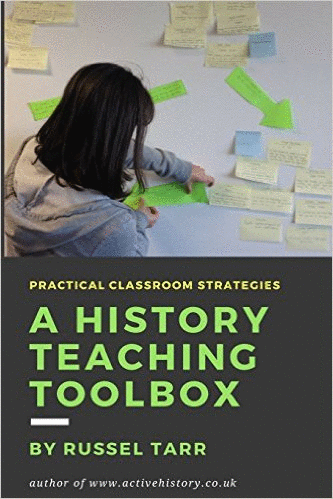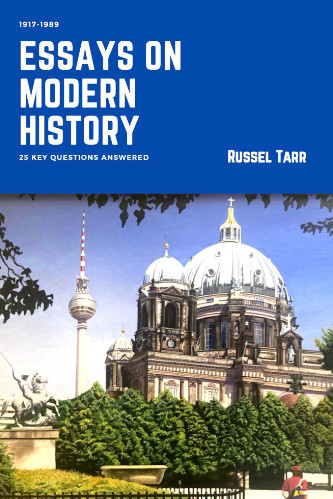World History teaching resources for the high school classroom: lesson plans, worksheets, quizzes and simulation games for KS3, IGCSE, IB and A-Level teachers.
The following scheme of work is designed to deliver the Cambridge IGCSE syllabus.
Introduction and Overview
Introduction and Overview: The Arab-Israeli Conflict since 1945
Students are provided with a narrative overview of the conflict, with the "hook" being the tragic events of September 11th 2001. This is explained in the context of the Arab-Israeli confict and students are provided with a diagram and supporting questions to help them put this into its wider geopolitical context.
Why did Britain give up its Mandate in Palestine?
Reason 1: Tensions in Palestine before 1939: Palestinians and Jews | Teacher Version
Students are provided with a 'fill the gaps' exercise and are then asked to identify from this three key reasons why Palestine was a source of tension even before the outbreak of World War Two.
Reason 2: Tensions in Palestine Increase: World War Two and the Holocaust
Students complete a detailed worksheet by watching a 35-minute video documentary about the Holocaust.
Reason 3: Tensions in Palestine 1945-1947 | Teacher Version
"Cut and paste each of the following events into the correct column. (US Pressure upon Britain | British (Empire) pressures | Jewish pressure upon Britain | Arab pressure upon Britain). If you have sufficient time, add a few relevant images in some of the blank cells adjacent to some of the key events"
End of topic examination-style test: the British mandate in Palestine | Teacher Version
Students are provided with a range of past examination questions on the British mandate in Palestine in the IGCSE "(a) Describe, (b) Explain, (c) Assess" format for Paper 1, and a template to help them start to answer these.
End of topic factual test: 20 questions on the British mandate in Palestine | Teacher Version
A factual test drawing toge the key events so far studied, in the form of a 'fill the gaps' timeline.
 UNSCOP and the United Nations Partition Plan
UNSCOP and the United Nations Partition Plan
1947 roleplay part 1: How should Palestine be divided between Arabs and Jews? | Accompanying Maps
In February 1947, UNSCOP (the United Nations Special Committee on Palestine) was set up to work out a solution for the future of Palestine. As the violence escalated, the committee considered 6 possible solutions. Students consider the merits of each, and with the help of various maps of the region.
The students are then divided into three groups - Arabs, Jews and Judges - for the next part of the roleplay.
1947 roleplay part 2: Task for the "Arabs" and "Jews"
"UNSCOP reported back in September 1947 proposing that Palestine should be divided into two separate states, with economic unity. In this exercise, you will draw up your own partition plan, and compare it to that decided upon by the United Nations"
1947 roleplay part 2: Task for the "Judges"
"Three people in the class will be in role as members of the UN. They will have to vote later on which of the proposals presented to them is the most likely to bring lasting peace to the region. In the meantime, they will start completing the worksheets on the various 1947 partition plans were actually considered".
What really happened?
Students consider, based on their own discussions, the merits and drawbacks of the actual partition plan settled upon by UNSCOP.
Civil War in Palestine, 1947-1948
The UN General Assembly (and the Jewish leadership in Palestine) voted to accept the UNSCOP partition plan in November 1947. The Arabs though rejected it. The outcome of this conflict was the first wave of Palestinian refugees, which remains one of the central problems in the region today. Students investigate this stage of the conflict through political cartoons and a 5-minute video clip.
The Arab-Israeli War of 1948
What territorial changes took place as a result of the 1948 war?
Students are given an overview of the main events, and two 'before and after' maps to draw some initial conclusions from.
Why did Israel win the 1948 war?
By analysing a timeline of events and watching some multimedia clips, students are challenged to find three key reasons why the Israelis won, and to link them.
What were the results of the 1948 war?
This exercise focuses particularly on "Al Nakba" ("The Castastrophe") - the Palestinian refugee crisis, with a discussion about whether the Palestinians have the 'right to return' to their lands in present-day Israel.
The Suez Crisis of 1956
Multimedia decision-making exercise (double-lesson)
This unit guides students step-by-step through the causes, events and consequences of the Suez Crisis. It also makes reference to the Sevres Protocol.
The 1967 Six-Day War
Causes of the 6-Day War | Teacher Notes
Students have to analyse a detailed timeline to determine how the four main combatant nations could be held mainly responsible for the outbreak of the war in 1967.
Events and Consequences of the 6-Day War
The causes for the Israeli victory, plus the long-term international consequences and for the Palestinians in particular, are covered in this lesson activity.
The development of the PLO to 1976
Did the actions of the PLO advance or undermine the Palestinian cause, 1970-1976? | Teacher notes
Students are put into two groups - Arabs and Israelis - to debate whether the actions of the PLO in the period 1970-1976 (Black September, Munich Olympics, Arafat of the UN, Operation Entebbe) advanced or undermined the Palestinian cause. To accompany this activity, you should download these photographic slides.
The 1973 October War
"As a result of the 1967 war, Egypt lost Gaza and Sinai, Syria the Golan Heights; Jordan lost the West Bank and East Jerusalem. UN Security Council Resolution 242 (1967) told Israel's to return these lands, and for Arabs to respect the right of Israel to exist. However, the Arabs refused to give recognition to Israel, and the Israelis refused to return the lands. So, the Israelis and the Egyptians were engaged in a costly war of attrition which meant there was no peace in the region."
Events / Consequences of the October War
Students are provided with 20 essential points of information which they need to categorise into three rows (Why were the Arab armies initially so successful? / Why did they nevertheless fail to secure an outright victory? / What were the consequences?) and then subdivide into different categories (USA / Egypt + Arab States/ Israel / USSR).
Twenty questions in a gap-fill exercise, complete with teacher answers.
The Camp David Agreement
The Camp David Agreement | Teacher Presentation
"The stalemate which resulted from the Yom Kippur war produced a balance of power between the two sides that made genuine compromise possible. Conduct your own research on each of these questions. Your teacher will lead a feedback session using a PowerPoint presentation afterwards".
Events since 1979
Events since 1979: Decision Making Exercise | Multimedia Slideshow
Students are provided with a detailed breakdown of the key events which took place after Camp David, and for each one students are presented with a decision point from either an Israeli or an Arab perspective to discuss before being provided by the teacher in the multimedia slideshow with information about what was actually decided. Students then use this to evaluate whether this event led to a rise or a decline in tensions, and who was primarily to blame / to be credited with this.

Conclusions
Detailed Summary Sheet: The Arab-Israeli Conflict since 1945
This summary sheet is completed up to 1978. The remaining rows are left deliberately blank for students to complete based on the most recent lessons in the unit.
Is the greatest hindrance to peace the UN, Israel, or the Palestinians? | Teacher Answers
To bring the topic fully up-to-date, students consider the divisions in the PLO (Hamas / Fatah), the UN (Security Council / General Assembly) and in Israel (Likud / Labor) and decide based on this information who is most responsible for the ongoing failure to secure peace in the region.

© 1998-2026 Russel Tarr, ActiveHistory.co.uk Limited (Reg. 6111680)
1 Torrin Drive, Shrewsbury, Shropshire, SY3 6AW, England
Privacy Policy | Contact






